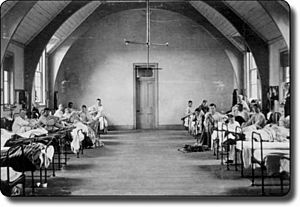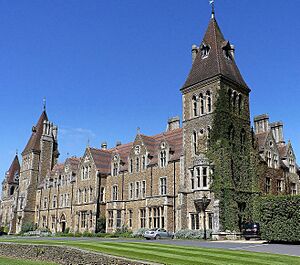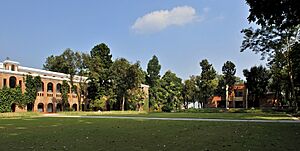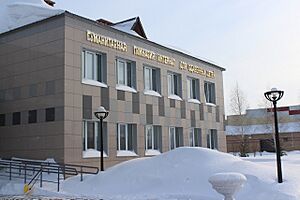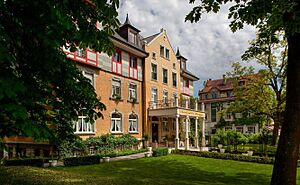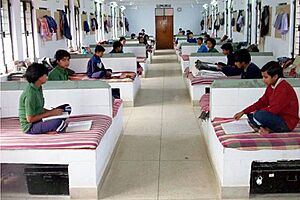Boarding school facts for kids
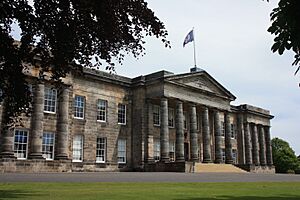
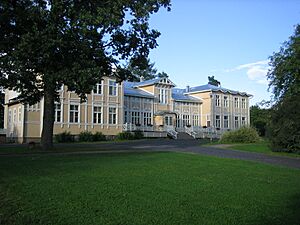
A boarding school is a school where students live and study on the school grounds. The word "boarding" means that the school provides both a place to live (lodging) and meals. These schools have been around for many centuries and are found in many countries.
Students who live at boarding schools are called "boarders." They might stay for a few years or until they are 18. Some boarders go home only at the end of the school year, while others go home at the end of each term or every weekend. There are also "semi-boarders" who attend school during the day and go home in the evenings. In some places, children spend most of their childhood and teen years away from their families at these schools.
Boarding schools are quite common in countries like the United Kingdom, India, China, and parts of Africa. In these places, children might start boarding school at a young age and stay for a long time. In Europe and the U.S., boarding schools are less common and are mostly for high school students (grades seven or nine through twelve). Some schools are for boys only or girls only, while others are for both boys and girls. The United Kingdom has a long history of boarding schools, and some, like Eton and Winchester, are known for educating future leaders.
In some societies, boarding schools are seen as a top choice for education. In other places, they might be used for children who need a different environment. For example, in the past, some schools in the United States and Canada were used to force indigenous children to adopt Western ways of life.
Contents
What is a Boarding School?
How Boarding Schools Work
Boarding schools often have special features, especially those inspired by older British schools.
Living in Houses
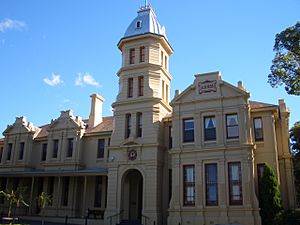
Most boarding schools have several separate buildings called "houses" or "dorms" where students live. These can be on the school grounds or nearby.
Teachers or other staff members, like housemasters or dorm parents, live in these houses. They act like parents, looking after 5 to 50 students, especially outside of school hours. They might have help from a housekeeper, sometimes called a "matron," and tutors for schoolwork. In the U.S., dorm parents often live with their families in the dorms. Older students might also have some responsibilities, like being "prefects," to help younger students. Houses often have their own unique feel and compete in sports.
Houses usually have bedrooms or dormitories, a dining room, a library, and places for students to do homework. They might also have common rooms for watching TV and relaxing, and kitchens for snacks.
Some houses have students of all ages, with older students helping the younger ones. Other schools have separate houses for different age groups. Day students, who go home at night, might also be part of a house for social activities and sports.
Most dorms have a "lights out" time when students need to be in their rooms and quiet. Students might try to stay up later, perhaps using computers or visiting other rooms. International students might use the time difference to talk to family or friends far away.
Other Cool Places at School
Besides classrooms, libraries, and labs, boarding schools often have many places for fun activities. These can include music rooms, gyms, sports fields, swimming pools, and theaters. Many schools also have a chapel. Day students often stay after school to use these facilities. Many North American boarding schools are in beautiful countryside areas.
The food at boarding schools can be different from school to school. However, most offer many choices for different diets. Some schools have a dress code for certain meals, like dinner. Students can usually eat with friends, teammates, teachers, and coaches. The dining hall is often a place where students and teachers can continue learning and talking. Some schools let day students eat breakfast and dinner too, sometimes for an extra fee.
Many boarding schools have a school store or snack bar where students can buy extra food and supplies. They might also have a student center for relaxation and snacks.
Boarding schools also have an infirmary, which is a small room for first aid or other medical help.
Daily Life and Time Off
Students usually need permission to leave the school grounds. They might be allowed to go off-campus at certain times.
Boarding schools offer different options:
- Full-time: Students live at school all the time.
- Weekly: Students stay at school Monday to Friday and go home for the weekend.
- Flexible: Students choose when to board, for example, during exam week.
Each student has a schedule, which is very structured for younger students. Boarders and day students learn together during school hours. After school, they often do sports, join clubs, or go on trips.
British boarding schools have three school terms a year, each about twelve weeks long. There are short breaks during the term when students go home or stay with guardians if they are international. Families are often encouraged to visit for sports games or school performances.
Some boarding schools have only boarders, while others have both boarders and day students. Day students go home at the end of the school day. Schools with both types of students are sometimes called semi-boarding or day boarding schools.
Other Kinds of Boarding Schools
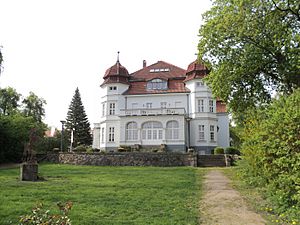
Not all schools where students live are like the "classic" boarding schools. Here are some other types:
- Traveling boarding schools: Like Think Global School, these high schools move to a new city each term. Students learn while exploring different cultures.
- Sailing boarding schools: These schools are on ships that travel around the world. Students learn both on board and in the ports they visit.
- Outdoor boarding schools: These schools teach students to be independent and self-reliant through camping and other outdoor activities.
- Residential education programs: These provide a safe and supportive place for children who might be facing difficulties.
- Schools for special needs: These schools help students with special educational needs.
- Semester schools: These offer a short, one-semester living experience with a special learning theme.
- Specialist schools: These focus on a particular subject, like science and math or arts.
- Public boarding schools: These are run by public school systems. In the U.S., some public boarding schools help students from remote areas or those who need extra support. For example, Crane Union High School in Crane, Oregon, helps students from far-off ranches avoid long commutes.
Rules and Guidelines
In the U.K., most boarding schools are private. They follow certain rules, especially for health and safety. For example, there are rules about how much space each student needs in a dorm room. A dorm for two or more students must have at least 4.2 square meters per student, plus 1.2 square meters. There must also be at least 0.9 meters between beds. Single rooms need at least 6.0 square meters. Schools must also provide at least one bathtub or shower for every ten students.
History of Boarding Schools
Boarding schools have developed differently in various societies. In some places, children start at a younger age. In some families, it's a tradition to send children to the same boarding school for many generations. Historically, more boys than girls attended boarding schools and for longer periods. The idea of sending children to live and learn together has been around for over 1,000 years in the U.K.
In Europe, during medieval times, boys were often sent to learn from educated churchmen in monasteries or noble homes. The King's School, Canterbury, founded around 597 AD, is one of the oldest boarding schools. Winchester College (1382) and Oswestry School (1407) are also very old boarding schools that are still open today.
United Kingdom
British boarding schools began in the Middle Ages. Many public schools started when monastery schools began to accept students who paid. These schools were often like the universities of Oxford and Cambridge and were mostly run by church leaders until the 1800s. While wealthy families often had tutors at home, especially for girls, it became more common for teenagers to be educated together after the 1500s.
Boarding preparatory schools prepare younger students for public schools.
During the time of the British Empire, British families living abroad would send their children to public schools in the U.K. to ensure they grew up with British culture. Local leaders in colonies were also offered this education for their sons. Boarding schools helped spread British ideas and values.
Sometimes, parents send children to boarding school to give them more experiences than they could get at home. A family might choose a school that many generations have attended. Or, they might choose a popular school hoping their children will meet people from important families. However, there can be other reasons, like if a child is struggling or if parents are divorced. These reasons are not always openly discussed.
In 1998, there were 772 private boarding schools in the United Kingdom, with over 100,000 students. About one percent of British children attend boarding schools, and some start as young as 5 to 9 years old.
United States
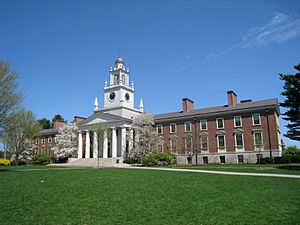
Before public schools were common in the United States, boarding schools were often the only option for high school students in rural areas. Some states helped pay for these schools, often called "academies." Some of the oldest academies still open today include West Nottingham Academy (started 1744) and Phillips Academy (started 1778).
As local governments started free public day schools, many academies either joined the public system or closed. Around the early 1900s, new boarding schools were created. These schools were often like British public schools and focused on preparing students aged 14–18 for college. They became known as prep schools. As of 2000, about 0.5% of U.S. school children attended boarding schools.
In recent years, some governments have opened public boarding schools. Some offer extra help for smart students, like the North Carolina School of Science and Mathematics (started 1980). Others provide a focused environment for students from challenging backgrounds.
Boarding schools for students under 13 are called junior boarding schools and are not very common. The oldest junior boarding school is the Fay School in Southborough, Massachusetts (started 1866).
Native American Schools
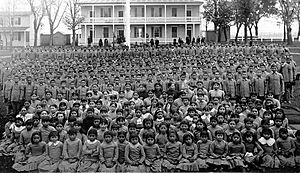
In the late 1800s, the U.S. government tried to teach Native American children Western culture so they would fit into Western society. At these government-run boarding schools, Native American students were taught ways of life different from their own.
For example, boys and girls were kept separate, and their interactions were strictly controlled. Girls learned skills like sewing, cooking, and cleaning, while boys learned farming and caring for animals. These ideas were very different from many Native American cultures, where women often had powerful roles and did tasks that Western society thought were only for men.
While some Native American children adopted these new ideas, many resisted the changes being forced upon them.
Canada
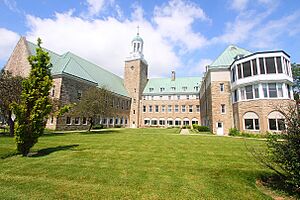
In Canada, the largest independent boarding school is Columbia International College, with about 1,700 students from around the world. Robert Land Academy in Wellandport, Ontario, is Canada's only private military-style boarding school for boys in Grades 6 through 12.
Other Commonwealth Countries
In many parts of the world, boarding schools are not the most common choice for raising children. However, they are a popular education option in some former British colonies or Commonwealth countries like India, Pakistan, Nigeria, and other parts of Africa. For example, in Ghana, most secondary schools are boarding schools. In countries like New Zealand and Sri Lanka, some public schools also have boarding facilities. These public boarding schools often have a similar feel to private ones, but usually only about 10% of their students are boarders.
Russia and Former Soviet Union
In the former Soviet Union, these schools were sometimes called Internat-schools. They had different purposes. Some were special schools focusing on subjects like math, physics, or languages. For example, in the 1960s, a new type of boarding school called an AESC (Advanced Educational Scientific Center) was created. These schools were part of major universities and prepared students to study there. Today, only a few exist in Russia.
Other Internat-schools were connected to orphanages. There were also separate boarding schools for children with special needs, like schools for the blind or deaf. Regular schools offered "extended stay" programs where children could get cheap meals and stay until their parents came home from work. In countries that were once part of the Soviet Union, boarding schools vary today.
Switzerland
The Swiss government has encouraged private boarding schools for international students as an important part of its economy. Swiss boarding schools teach in several major languages and have many high-quality facilities. Some of the most expensive boarding schools in the world are in Switzerland, including Institut auf dem Rosenberg and Institut Le Rosey.
Japan
In Japan, there are several international boarding schools run by private groups. Examples include NUCB International College and Hallow International School. These schools follow different education systems, like the IB or A-Level, and mostly teach in English.
China
As of 2015, there were about 100,000 boarding schools in rural areas of Mainland China, with about 33 million children living in them. In China, some children are sent to boarding schools as young as 2 years old. Most boarding schools are in western China, which is generally not as wealthy as eastern and central China. Many children of migrant workers and farmers attend these schools.
India
In India, there are many types of boarding schools, run by both private groups and the government. Some government-run schools include Jawahar Navodaya Vidyalaya and Ekalavya Model Residential School. Indian boarding schools follow various education systems, like CBSE and ICSE, and mostly teach in English.
How Boarding Schools Affect Students
Some very selective boarding schools that prepare students for university are seen by experts as places where future leaders of society are shaped. Families who value power and social standing often choose these schools. Students from these schools often feel they are meant to be in charge of society. Many go on to become political leaders or work in finance. This type of schooling can make students feel very entitled and in control. This is sometimes called "deep structure socialization," meaning the schools control not just students' daily lives but also their feelings.
This can lead to students strongly sticking to social roles and strict ideas about gender. In one study, the pressure to fit in was so strong that some students used certain medications to improve their school performance or lose weight. The way students form groups, especially in the dining hall, can show how strict the social rules are. This can lead to bullying and strong competition. Students might find it hard to show real feelings or have close relationships, often acting in ways that make them seem important in the social order. This can affect how they see gender and social roles later in life.
Emotional Impact
Living at a boarding school 24/7, studying, sleeping, and socializing with the same people, can create pressure and stress. This can lead to intense competition, and sometimes, students might feel very sad or depressed. Studies show that about 90% of boarding school students feel that living in such an environment greatly changes how they see and interact with others.
Being away from parents and their home culture for a long time can make children feel homesick or emotionally abandoned. This can lead to a feeling of being a "third culture kid," someone who doesn't fully belong to their home culture or the culture they grew up in at school.
Robert Graves, a famous British writer who went to six different boarding schools as a child in the early 1900s, wrote that boarding school life felt completely separate from home life. He said students had different words, different rules, and even different voices at school. When they returned to school after holidays, they changed back to their "school-self" almost instantly. He felt that school life became the real world, and home life felt like an illusion.
Some modern ideas about education suggest that daily interaction between children and parents is very important for learning and development. Being separated from parents, especially when young, can affect a child's emotional growth. An international project on child development in 2003 considered boarding schools a form of "permanent displacement" for children. This view comes from new scientific understanding of the human brain and how children develop.
Experts are still gathering information on how many boys versus girls attend boarding schools, the total number of children in boarding schools in different countries, the average age children start, and how long they stay. There is also more to learn about all the reasons why parents choose to send their children to boarding schools.
Boarding School Syndrome
The term boarding school syndrome was created by psychotherapist Joy Schaverien in 2011. It describes a group of long-lasting emotional problems seen in adults who went to boarding school at a young age.
Schaverien suggests that children sent away early lose their main connections to family, which can be a big emotional shock. If they experience bullying or abuse, new adult figures might not feel safe. To cope, children might hide their true feelings and identity. This can make close relationships difficult later in life.
Another psychotherapist, Nick Duffell, calls adults who went through boarding school separation "boarding school survivors." He says some of these individuals might feel distant in relationships, work too much, or feel a need to control things.
Boarding Schools in Books and Movies
Boarding schools have been a popular setting in books and movies for a long time, especially in British stories. These stories often show characters who sometimes break school rules for good reasons, and might get punished, but usually don't completely rebel against the school system.
Books
Some famous books set in boarding schools include:
- Sarah Fielding's The Governess, or The Little Female Academy (1749)
- Charles Dickens's Nicholas Nickleby (1838)
- Charlotte Brontë's Jane Eyre (1847) and Villette (1853)
- Thomas Hughes's Tom Brown's Schooldays (1857)
- Frances Hodgson Burnett's A Little Princess (1905)
- Elinor Brent-Dyer's Chalet School series (1925–1970)
- Erich Kästner's The Flying Classroom (1933)
- James Hilton's Goodbye, Mr. Chips (1934)
- Ludwig Bemelmans' Madeline series (1939–present)
- Agatha Christie's Cat Among the Pigeons (1959)
- Penelope Farmer's Charlotte Sometimes (1969)
- Jill Murphy's The Worst Witch stories (from 1974), which are about a magic school.
- Dianna Wynne Jones's Witch Week (1982)
- J. K. Rowling's Harry Potter series (1997–2007)
- Jenny Nimmo's Children of the Red King series (2002–2009)
- Libba Bray's Gemma Doyle Trilogy (2003, 2006)
- Enid Blyton's Malory Towers, St Clare's and Naughtiest Girl series
- John van de Ruit's Spud book and movie series
North American books set in boarding schools include:
- J.D. Salinger's The Catcher in the Rye (1951)
- John Knowles's A Separate Peace (1959)
- Robert Cormier's The Chocolate War (1974)
- John Green's Looking for Alaska (2006)
Films and Television
- Tom Brown's Schooldays (1916)
- Mädchen in Uniform (1931)
- Goodbye, Mr. Chips (1939)
- The Happiest Days of Your Life (1950)
- The Belles of St. Trinian's (1954)
- The Children's Hour (1961)
- If.... (1968)
- The Facts of Life (1979–1988)
- Taps (1981)
- Pink Floyd – The Wall (1982)
- Dead Poets Society (1989)
- School Ties (1992)
- A Little Princess (1995)
- Madeline (1998)
- Young Americans (2000)
- Harry Potter and the Philosopher's Stone (2001)
- Cadet Kelly (2002)
- The Emperor's Club (2002)
- Rebelde Way (2002–2004)
- Strange Days at Blake Holsey High (2002–2006)
- Code Lyoko (2003–2007)
- Les Choristes (2004)
- Yu-Gi-Oh! GX (2004–2008)
- Winx Club (2004–2019)
- Zoey 101 (2005–2008)
- She's the Man (2006)
- Hanazakarino Kimitachihe (2006)
- Wild Child (2008)
- Archer (2009–2023)
- Spud (2010)
- Barbie: Princess Charm School (2011)
- House of Anubis (2011–2013)
- Ever After High (2013–2016)
- Descendants (2015)
- My Hero Academia (2016)
- Legacies (2018–2022)
- Fate: The Winx Saga (2021–2022)
- The Boarding School: Las Cumbres (2021–2023)
- Young Royals (2021–2024)
- Pokémon Horizons: The Series (2023–present)
Video Games
- Final Fantasy VIII (1999)
- Bully (2006)
- The Sims 3 (2009)
- Katawa Shoujo (2012)
- Life Is Strange (2015)
- Fire Emblem: Three Houses (2019)
- The Walking Dead: Final Season (2018)
See also
 In Spanish: Internado para niños
In Spanish: Internado para niños


